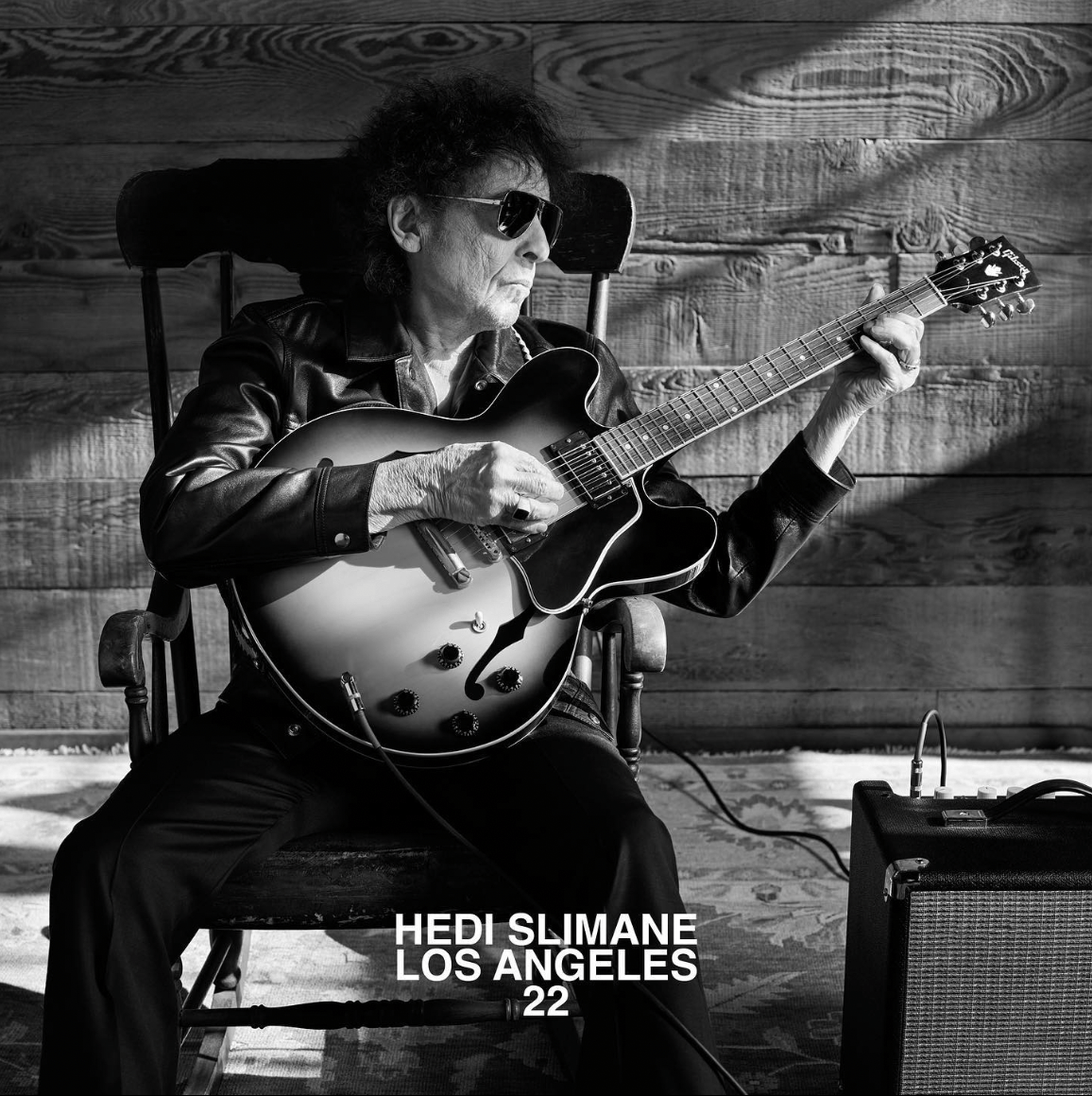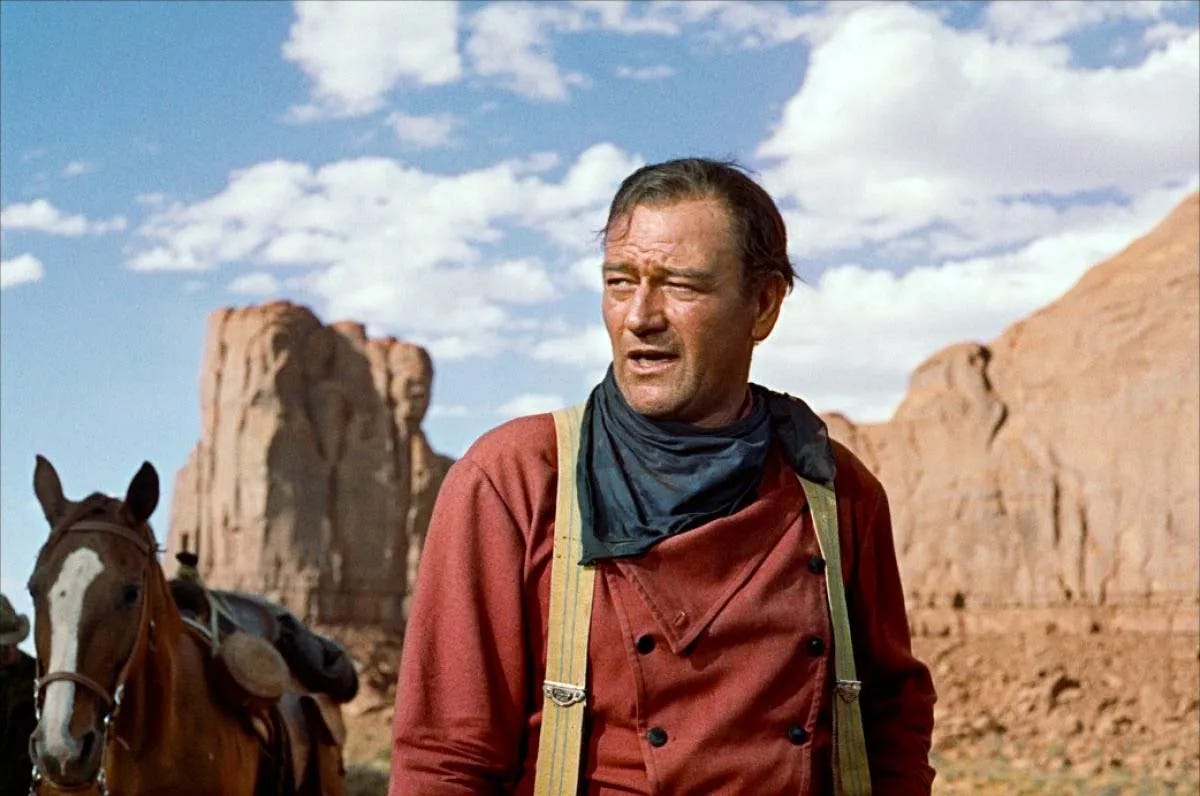An Ode to the Outlaw (and the endurance of Westerns)
Why do we love outlaws, and how does the Western genre persist?
Here beyond men’s judgements all covenants were brittle.” - Cormac McCarthy
I recently saw innovative fashion designer/style demigod Hedi Slimane’s photo campaign released for Celine’s FW23 collection starring Bob Dylan in a sun-beat, wood-paneled room playing a hollow-body electric guitar in an ancient rocking chair, donning aviator shades and a tailored leather jacket. Slimane is known for popularizing the “indie sleaze” aesthetic: tapered black jeans, slim silhouettes and elevated Americana looks with a European touch, like Wim Wenders’ Paris, Texas embodied in garments. Celine’s fall/winter collection is no different, and Dylan is the perfect model and muse. My adoration of the Dylan ethos aside, the campaign works; he looks like a man with the secrets of life that can only be gained by a singular, storied existence. You know you’ll only look half as cool in the jacket, but even that is cool enough. The Dylan images are a testament to the idea that fashion changes, but style never dies. How did an 81-year old man— whose face shows all eight decades of wear— pull off the role of spokesperson for arguably the most respected high-fashion house in business right now?
My best guess: icons of rebel culture are forever cool.
For as long as I can remember, I’ve been enamored with rebellion, outlaws, counter culture— however you want to describe it. I don’t think I enjoy rebellion for the sake of being difficult, either. I’m predisposed to believe in people. Despite the pain pervasive in our world, I find myself looking at the minutiae of the human experience through rose-colored lenses; I’m a positive guy. I cherish niche communities, close relationships and genuine kindness. I’m not inherently defiant to authority. There’s even a video of me tucked somewhere in the Draper Home Video Archives, tears caked across my four-year old face as I sing Lee Greenwood’s “Proud to be an American'' in the embers of 9/11.
Generally, I think I am drawn to three core traits emblematic of rebellion: the freedom of expression, the zaniness of the human condition personified and the idea that even imperfect souls can live a galvanizing, revolutionary life. Whether it’s art about rebels or rebels making the art, I know I’m not the only one that feels this way; some of the world’s most influential visionaries are singularly associated with outlaw culture.
It started when I was younger. Thanks to my dad, I grew up on the likes of Dylan and the Grateful Dead, among other classic acts of the 60’s and 70’s. Beyond learning the benefits of expansive 15-minute jam sessions, Shakespearean verbosity as a musical tool and drug use to augment creativity, I enjoyed the personas behind the artists even more. I dove into biographies; I learned about the Electric Kool-Aid Acid Test, the Hell’s Angels’ murder of a concertgoer at Altamont and Ozzy Osbourne biting the head off a bat. I was enamored. In school, I had to write an essay about my favorite poet, and in what was maybe a small act of personal rebellion wrote about Bob Dylan. I look back on my young self with fondness, but embarrassment— I could’ve picked, you know, any actual legendary poet (to be fair, classic poets and novelists came later in my art discovery phase).
As I got into college and began my own era of rebellion (doing whip-its in a detached garage in the wee hours of a muggy, suburban, midwestern morning), I developed what I perceived as highbrow tastes in counter-cultural art and books, but were actually more basic starting points. My arsenal of interests were college dorm room posters personified. I fell in love with William S. Burroughs’ gut-punching satire exposé on the drug addiction taboo, the absurd lore behind Hunter S. Thompson and the surrealist dreamscape of Salvador Dalî. Even more, I learned to appreciate Jackson Pollock’s artistic entropy (even if he was paid by the CIA to use his art as anti-Soviet propaganda) and Faulknerian characters— intense, cunning and intelligent figures hidden behind a deeply simplistic, southern veil.
Around this time, I realized I simply had an affinity for the antihero archetype. It’s difficult for people that view themselves as Good Humans to come to terms with the idea that they might be the Bad Guys, so the ones that embraced their imperfect morality always moved me. Maybe this fear plagues me deep in my subconscious— these characters are more relatable to me than the stud in the tailored suit with a million-dollar smile and a penchant for charity. It’s why I idolized so many other profoundly flawed figures, like Anthony Bourdain or Townes Van Zandt. It’s also how my tastes led me to the big screen; since the dawn of Hollywood, the antihero figure has loomed large over the medium.
This type of figure is best embodied on film by Western movies, which I also believe are the perfect use case for why we like the outlaw. An enduring genre, the first popularized Western was 1903’s The Great Train Robbery, a silent film in which the characters live out the title of the movie. Their so-called “Golden Age” was between 1940 and 1960, when the powerhouse John Wayne-John Ford actor/director duo churned out some of the genre’s most memorable works— most notably, Stagecoach and The Searchers. Remnants of the Greatest Generation and languishing Baby Boomers lament the end of this “Golden Age”, but the truth is, Westerns never truly died. They only changed.
“Westerns reflect the decade in which they were made more than musicals, period dramas, and comedies.” - Quentin Tarantino
Motifs in Western flicks transformed over time to reflect the cultural environment in which they came out in, but never disappeared as a sub-genre entirely. While the racist, Native American-hating Confederate war veteran protagonist in John Ford movies of yesteryear didn’t stand the test of time well, they still maintained the spirit that makes Westerns alluring: an imperfect lead plagued by their untenable actions of the past and present, trying to do right by his morals in a world that exists untethered from society’s expectations. The archetype persists.
The 1970s saw Blazing Saddles’ tragicomic touch add new wrinkles to what a Western could be, or John Wayne’s semi-autobiographical last film, The Shootist, about an expiring cowboy who’s the last of his breed; in the 1990s, Clint Eastwood’s career saw a resurgence beside Morgan Freeman in Unforgiven, a story about empathy for society’s pariahs; the aughts and 2010s found Western films back in vogue, with No Country for Old Men’s bleak world devoid of soul or The Hateful Eight’s commentary on the world’s misogynistic and racist tendencies, shedding light on today’s issues behind a thin veil of late-19th century prejudices that still remain today.
No matter the era, the “moral” or the attitude, at its core, Westerns— life on the frontier, on the hard-line edge of existence— provide a moving framework to tell a story. There’s allure in the fragility of this existence; at any moment for our protagonists, it all comes crashing down. They live life without reservation— like icons of history who believe in their imminent demise— and sometimes lean too far over the cliff. In some cases, their demise truly is inevitable, which makes their journey all the more biblical, futile and tragic.
These rebel figures live in a realm beyond legal and social contracts, one that doesn’t adhere to society’s arbitrary standards, where brazen justice and sinister evil rule alike in a lawless forlorn land. In this framework, you can tell any story you like. New works can explore old themes in fresh ways, or create new threads in the genre alike. The movie, show, book or song could be created by a student of the genre who grew up enamored with the larger-than-life cowboy persona, or a figure considered by society an “outlaw” themselves; if the story is told righteously and true, the art will endure.
Here’s to the Western, and to the outlaw— may they never die.




